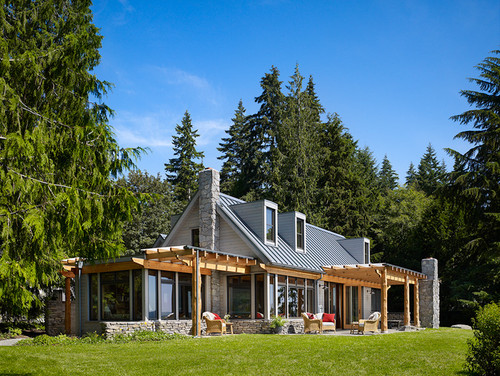By Julie Ryan Evans | Jul 8, 2019

Countless Monopoly games have been won and lost over the placement of tiny green houses (as well as slightly larger red hotels, but that’s another story). But if you’ve ever inspected these pieces of plastic, you’d see that they’re actually miniature versions of the popular home architecture known as Cape Cod design. All of which begs the question: What is a Cape Cod house, anyway?
Characteristics of a Cape Cod house
These New England homes are named, of course, after Cape Cod—the place that gave them their start. This beloved vacation destination is located off the coast of Massachusetts and is known for its breathtaking beaches and quaint little towns.
In the 1600s, Cape Cod gave birth to its namesake style of home, which was built to withstand harsh New England winters. As such, cottages in Cape Cod typically had the following features:
- A simple rectangular shape and small (one-story) size, though some Cape Cod house plans are one-and-a-half level or three-quarter Cape (Due to the extreme cold of New England winters, the smaller the cottage, the easier and less expensive it was to heat.)
- A steep, slanted, gabled roof (sometimes side-gabled) to help snow melt off
- A central chimney in the middle of the home (all the easier to heat the space) connected to fireplaces in many rooms
- Cedar shutters and shake shingles to protect against strong winds
- Double-hung, multipane windows
- Low ceilings, which also help conserve heat
- A simple floor plan with a front door opening to a central hall, offering equal space on either side for living and dining rooms
- No porch, roofline, or other ornamentation (except for simple clapboard siding, shingles, and shutters) (A typical early Cape home wouldn’t have dormers, though later iterations might include two symmetrical ones.)
Postwar Cape Cod boom
After soldiers returned home from World War II, Boston architect Royal Barry Willis was instrumental in the spread of Cape Cod homes in suburbs across the United States—starting in New England and moving westward. Young families flocked to them because of their affordability, especially during the Great Depression.
Modern takes on the Cape Cod style
The Colonial-era Cape Cod home style is still going strong today, both in New England and other parts of the country. A Cape Cod uses many different construction materials for roofs and siding, and may add features like porches or gables, but it retains the style’s traditional characteristics. Below is a gorgeous example of a Cape Cod–style home with dormers and a chimney in the Pacific Northwest:

Capes fall into the midrange cost when it comes to building, as you can lose some livable space because of the architectural style (namely, the steep roof and its rafters). Still, it’s considered an affordable and practical housing style for both a main residence or a summer home, plus it features Colonial Revival flair.
If you want the feel of a New England Cape, a Cape Cod–style house may be available to shop for wherever you live. Or at the very least, you can divulge some fun trivia related to Cape Cod–style homes during your next Monopoly game.
Julie Ryan Evans is an editor and writer who has covered everything from politics to pop culture and beyond. She loves running, reading, cold wine, and hot weather. Follow @julieryanevans
